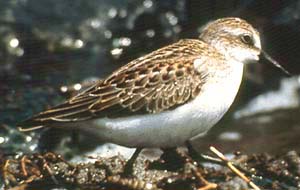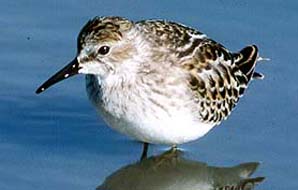

The Semipalmated Sandpiper was photographed in Delaware with a large group of Semipalmated Sandpipers. This variant plumage was a topic of discussion recently on "Frontiers of Bird Identification." Larry Sansone suggested I might post a photo which would illustrate what people were talking about and this is the best one I could find in my collection. The existence of this morph is discussed by Dennis Paulson in "Shorebirds of the Pacific Northwest" and an interesting color photo may be seen on page 250 of that work. Paulson specifically mentions the great variation in the juvenal plumage of Semipalmated Sandpiper and regards it as a topic for future research. I agree that this morph is most likely to be mistaken for juvenile Red-necked Stint C. ruficollis. Martin Reid has done an outstanding analysis of this problem, and I encourage everyone to reread his excellent and cautious comments.
The purpose of the second photo was to illustrate that Least Sandpipers in juvenal plumage may be very bright and strongly patterned. These birds are sometimes confused with Long-toed Stint. C. subminuta. The two are said to have a different forehead pattern, with Least have a white forehead and Long-toed having dark. However this difference is not reliable as seen here. More reliable differences are the patter on the lores. On Long-toed the dark lore stripe is incomplete, bending down forming a "J" in front of the eye allowing the white supercilium to connect to the white at the base of the lower mandible . The National Geographic Field Guide to the Birds of North America misrepresents this pattern in the illustration, and the text incorrectly emphasizes the forehead pattern.
The original images contributed by Albert Ghiorso and Peter LaTourrette are below. Both were photographed at the end of August. Thanks again to all of you who commented publicly for the excellent and thoughtful analysis.
 |
 |
Color perception has been a chronic problem in assessing photographic images on the web. This problem is compounded by the wide variety of hardware and software used to view these images. Please adjust your video to the highest possible number of colors. My logs show that over 25% of visitors view these pages with only 256 colors (8 bit). Sixteen bit (high color) is minimum and 24 bit (true color) desirable. Also you may wish to calibrate your monitor against a color standard and ensure that brightness and contrast are set correctly.